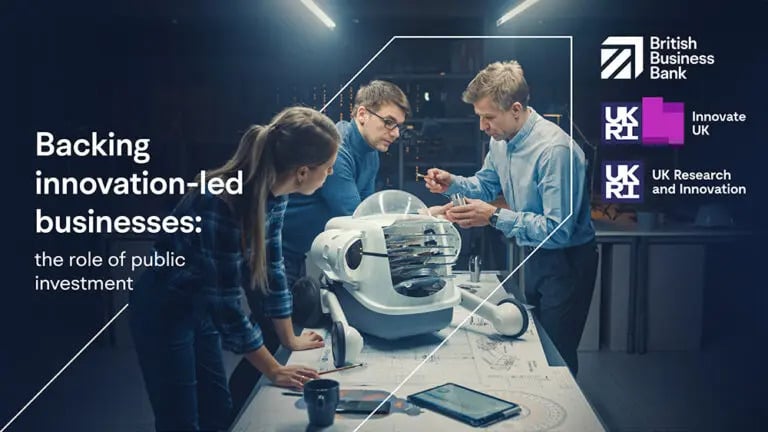Report and publications
The ‘Backing innovation-led businesses: the role of public investment’ report examines, for the first time, how the programmes delivered by the Bank and UK Research – including Innovate UK – interact and where there is crossover. This will help inform future policy in both organisations, as well as innovation policy in government more widely.
The report has four main chapters
Chapter 1: Crossover in support for innovation-led businesses
Examines the natural crossover of recipients of UKRI (including research councils and Innovate UK) and Bank-backed support, covering key aspects like finance type accessed, and the sequence of support received.
Chapter 2: Outcomes for innovation-led businesses
Considers the outcomes for innovation-led businesses in receipt of support from UKRI and/ or the Bank, with a focus on ‘research council spinouts’. Metrics include: business survival, employment and access to equity capital
Chapter 3: Innovation-led businesses, finance and place
Considers access to finance patterns for innovation-led businesses – again with a focus on ‘research council spinouts’ – in a geographic context. In particular, the Golden Triangle (Oxford, Cambridge, London) is compared with the rest of the UK
Chapter 4: Looking forward
Details how the Bank and UKRI are responding to the insights presented in this report, through a number of forward-looking initiatives
Key findings:
1. Crossover between ‘research council spinouts’, companies receiving R&D project funding from Innovate UK and recipients of investment through a British Business Bank programme is strong
a. 148 spinout companies that have emerged from UK research institutions as a result of UKRI research council grants went on to receive support from both the Bank and Innovate UK. A further 619 received support from Innovate UK but not the Bank, and 92 from the Bank without Innovate UK. In total. 19% of the Bank’s UK equity portfolio were ‘research council spinouts’ and/or had received support from Innovate UK.
2. ‘Research council spinouts’ with support from both Innovate UK and the Bank have almost double the survival rates and much stronger employment growth
a. For ‘research council spinouts’ founded between 2010 and 2014, 97% that went on to receive support from both the Bank and Innovate UK were active as at 26/02/2022. This means that those with support from both organisations are 17x less likely to have closed.
b. There are also large differences in employment outcomes. The median ‘research council spinout’ with support from both the Bank and Innovate UK had 18 employees, compared to 4 for those without support from either.
3. ‘Research council spinouts’ with support from both the Bank and Innovate UK were four times as likely to have raised external finance
a. 94% of ‘research council spinouts’ with support from both the Bank and Innovate UK had raised at least one round of external equity finance, compared to 20% of those without support from either. This discrepancy not only persists but worstens through the next few rounds of follow-on finance.
b. Differences in the value of capital raised is are even more significant. The median value of equity investment raised by spinouts with funding from both the Bank and Innovate UK in the first eight years of being incorporated was £7.3m, compared to £1.6m for those without funding from either
4. Equity-backed spinouts are found across the UK, but those in the Golden Triangle secured four times more investment
a. 46% of UK equity deals taking place between 2011 and 2021 went to London-based businesses, however only 17% of ‘research council spinouts’ in the sample analysed were based in the capital.
b. Geographic challenges remain for innovation-led businesses located outside of the Golden Triangle. 53% of ‘research council spinouts’ founded between 2010 and 2014 in the Golden Triangle raised at least one round of equity finance, compared to 40% in the rest of the UK. For those that did raise, the median company raised 4x more finance in the first eight years (£5.7m compared to £1.4m).
5. Supporting and financing innovation doesn’t follow a standard sequence: businesses need different and tailored types of support, in different combinations and at different times
a. Almost as many businesses received support from the Bank before their first Innovate UK award (46%) as they did afterwards (54%). This shows that financing innovative businesses is not a simple escalator, where a company graduates from grant financing onto equity and then debt finance markets, but the different support types complement each other.

Backing Innovation-Led Businesses 2022 Download
The ‘Backing innovation-led businesses: the role of public investment’ report examines, for the first time, how the programmes delivered by the Bank and UK Research.